John Seerey-Lester
Artist: 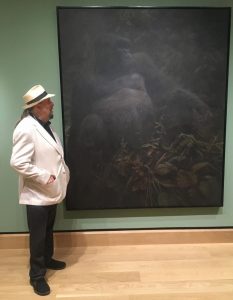 John Seerey-Lester
John Seerey-Lester
Genre: Realist, wildlife, equestrian, landscape
Media: Oil on canvas and panel; acrylic on canvas and panel; mixed media
Gallery: Call of Africa’s Native Visions Gallery
Website: http://www.seerey-lester.com
Facebook: http://www.facebook.com/pages/John-Seerey-Lester/197172706978053
His Art:
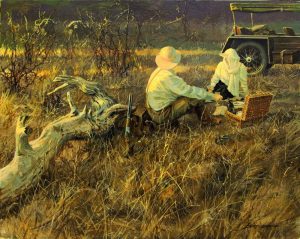 John Seerey-Lester’s career spanned nearly five decades, but it can be divided into roughly two phases. Having picked up a brush when he was but nine and having earned his first commission at the tender age of 13, the artist turned professional in 1974 after a detour into the world of journalism and freelance writing. For the next five years, he focused primarily on portraiture and nostalgic streetscapes from Victorian and Edwardian times, where he married his lifelong
John Seerey-Lester’s career spanned nearly five decades, but it can be divided into roughly two phases. Having picked up a brush when he was but nine and having earned his first commission at the tender age of 13, the artist turned professional in 1974 after a detour into the world of journalism and freelance writing. For the next five years, he focused primarily on portraiture and nostalgic streetscapes from Victorian and Edwardian times, where he married his lifelong 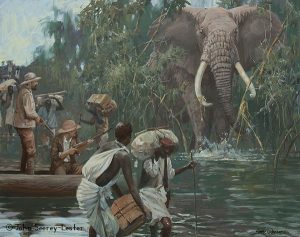 passion for history with his creative, artistic side.
passion for history with his creative, artistic side.
A turning point in John’s career came in 1979 when, inspired by his respect for fellow English artist David Shepherd, John made an excursion to Nairobi. The trek through East Africa convinced John to switch genres to wildlife art. The trip also fostered in Seerey-Lester a commitment to personally observe the animals he paints in their natural habitat. 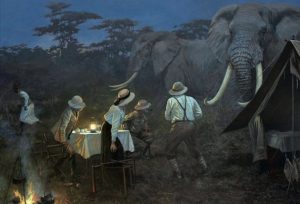 To give impetus to that resolve, John subsequently returned to Africa numerous times and traveled to Canada, Alaska, Central and South America, India (to paint tigers), Nepal, China (where he painted rare Giant Pandas in the wild) and even Antarctica.
To give impetus to that resolve, John subsequently returned to Africa numerous times and traveled to Canada, Alaska, Central and South America, India (to paint tigers), Nepal, China (where he painted rare Giant Pandas in the wild) and even Antarctica.
Although he continued to paint both portraits and figurative work, 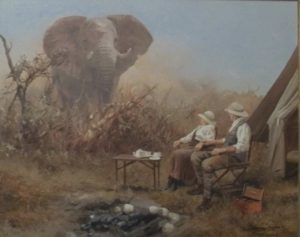 Seerey-Lester’s career in the wildlife genre became so storied that some conferred on him the moniker of “the Godfather of Wildlife Art.” Today, however, many associate John’s name with a series of 110 paintings based on 85 true-life stories he began several years ago that depict fictionalized scenes from the Golden Age of Hunting, which began circa 1850 and extended all the way to 1930.
Seerey-Lester’s career in the wildlife genre became so storied that some conferred on him the moniker of “the Godfather of Wildlife Art.” Today, however, many associate John’s name with a series of 110 paintings based on 85 true-life stories he began several years ago that depict fictionalized scenes from the Golden Age of Hunting, which began circa 1850 and extended all the way to 1930.
“When 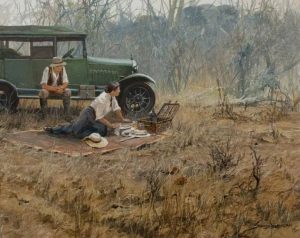 most of those events … took place,” John wrote in 2009 in the Forward of his book, Legends of the Hunt, “there was limited photography or none at all. These images are from my imagination based on the facts as we know them. I pose the models, lay out the artifacts and refer to the many sketches I have done on location, and then compose the painting. They are not illustrations – they are paintings inspired by real events and are hopefully works of art in their
most of those events … took place,” John wrote in 2009 in the Forward of his book, Legends of the Hunt, “there was limited photography or none at all. These images are from my imagination based on the facts as we know them. I pose the models, lay out the artifacts and refer to the many sketches I have done on location, and then compose the painting. They are not illustrations – they are paintings inspired by real events and are hopefully works of art in their 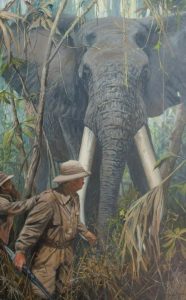 own right that bring to life the stories I have retold.”
own right that bring to life the stories I have retold.”
John’s series Campfire Tales not only included paintings chronicling the safaris of the early 1900s in Africa and India, but also took a nostalgic look back at North America’s hunting heritage. Each painting depicts an actual event in hunting history and is accompanied by the story behind the piece.
John followed Campfire Tales with The Legendary Hunts of Theodore Roosevelt, and his fourth and final book, Legendary Hunters and Explorers, will be published posthumously later in 2020. Teddy Roosevelt was John’s favorite subject and he was appropriately named the “preeminent modern-day painter of Theodore Roosevelt.”
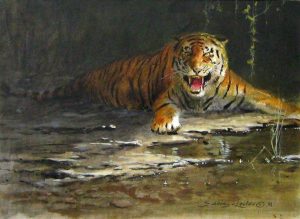 To render these marvelous works of art, Seerey-Lester assumed the roles of anthropologist, naturalist, historian, costume designer, set designer, director, artist and author. It all started with an exciting review of the journals maintained by iconic huntsmen like Teddy Roosevelt, Ernest Hemingway, Kalman Kittenberger and Fritz Schindelar, as well as famous huntswomen including Beryl Markham, Karen
To render these marvelous works of art, Seerey-Lester assumed the roles of anthropologist, naturalist, historian, costume designer, set designer, director, artist and author. It all started with an exciting review of the journals maintained by iconic huntsmen like Teddy Roosevelt, Ernest Hemingway, Kalman Kittenberger and Fritz Schindelar, as well as famous huntswomen including Beryl Markham, Karen 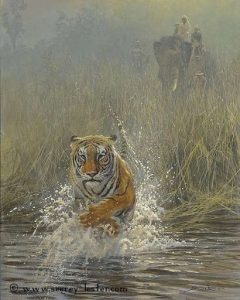 Blixen, Florence Baker and Mary Kingsley. From there, however, the research could become a little tedious since it necessitated outfitting his subjects with historically-accurate guns, clothing, camping gear and other artifacts. John was assisted in the endeavor by the National Rifle Association and he also collected a considerable number of rifles and hunting gear over the years for his paintings. “I have all of the guns now and most of the clothing,” Seerey-Lester once noted, “which I give to the models that pose for the scenes I create based on my research.”
Blixen, Florence Baker and Mary Kingsley. From there, however, the research could become a little tedious since it necessitated outfitting his subjects with historically-accurate guns, clothing, camping gear and other artifacts. John was assisted in the endeavor by the National Rifle Association and he also collected a considerable number of rifles and hunting gear over the years for his paintings. “I have all of the guns now and most of the clothing,” Seerey-Lester once noted, “which I give to the models that pose for the scenes I create based on my research.”
For Seerey-Lester, the accuracy of his paintings was crucial. 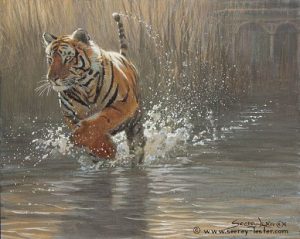 His aim with each piece was to recreate a real event and bring to life something that happened before the common use of photography. But, the artist was quick to point out, “I have dramatized their stories, but never changed the facts. They are all based on real events.” Fortunately, fiction couldn’t be more amazing.
His aim with each piece was to recreate a real event and bring to life something that happened before the common use of photography. But, the artist was quick to point out, “I have dramatized their stories, but never changed the facts. They are all based on real events.” Fortunately, fiction couldn’t be more amazing.
While each of the paintings in both his Legends of the Hunt and Campfire Scenes series dramatically tells a story, Seerey-Lester 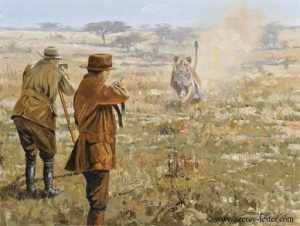 never let the viewer forget that he or she is looking at a painting. Each canvas and wood panel is marvelously textured and built layer upon layer through the use of powerful yet economic brushstrokes. Although a realist, the painter refused to get lost in unimportant details and broad expanses of his support often display almost impressionist stylings which serve to strategically enhance the impeccable
never let the viewer forget that he or she is looking at a painting. Each canvas and wood panel is marvelously textured and built layer upon layer through the use of powerful yet economic brushstrokes. Although a realist, the painter refused to get lost in unimportant details and broad expanses of his support often display almost impressionist stylings which serve to strategically enhance the impeccable 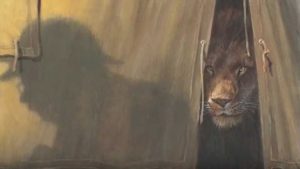 details provided where they matter. Each is a work of art that demands and delivers a mastery of not only wildlife art, but figurative work, portraiture, equestrian art, landscape and floral art, and elements of the still life.
details provided where they matter. Each is a work of art that demands and delivers a mastery of not only wildlife art, but figurative work, portraiture, equestrian art, landscape and floral art, and elements of the still life.
John Seerey-Lester was not only one of the biggest names in wildlife art 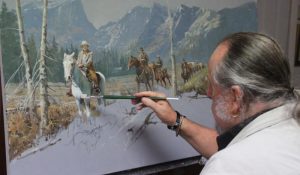 and was frequently called “The Godfather of Wildlife Art.” He was one of the most accomplished and versatile contemporary artists anywhere in the world.
and was frequently called “The Godfather of Wildlife Art.” He was one of the most accomplished and versatile contemporary artists anywhere in the world.
Awards and Accomplishments
John Seerey-Lester’s 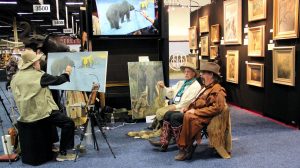 originals can be found in some of the most prestigious private and museum collections in the world, including the permanent collection of the White House, and The Society of Animal Artists presented him with their Lifetime Achievement Award in 2019.
originals can be found in some of the most prestigious private and museum collections in the world, including the permanent collection of the White House, and The Society of Animal Artists presented him with their Lifetime Achievement Award in 2019.
Conservation
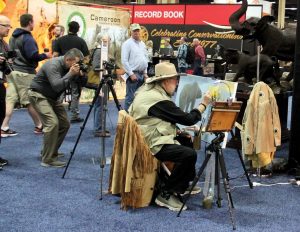 John was known for his generous support of conservation organizations, and was honored to be part of the Boone and Crockett Club, Campfire Club of America, NRA – ILA and HLF, Artists for Conservation, St. Hubertus, Society of Animal Artists, among others. His Imperial and Royal Highness, Archduke Andreas of Austria recognized his work in conservation by knighting him, and Artists for Conservation conferred their Sime Combes Award for
John was known for his generous support of conservation organizations, and was honored to be part of the Boone and Crockett Club, Campfire Club of America, NRA – ILA and HLF, Artists for Conservation, St. Hubertus, Society of Animal Artists, among others. His Imperial and Royal Highness, Archduke Andreas of Austria recognized his work in conservation by knighting him, and Artists for Conservation conferred their Sime Combes Award for 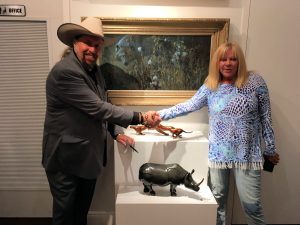 Conservation on John and wife wife Suzie in 2014. He was also a recent recipient of the NRA’s Hunter’s Leadership Forum Award for his work in conservation.
Conservation on John and wife wife Suzie in 2014. He was also a recent recipient of the NRA’s Hunter’s Leadership Forum Award for his work in conservation.
Fast Facts.
- John was born in Manchester, England. He died May 19, 2020 after a brief battle with cancer.
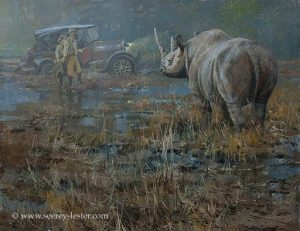 John immigrated from native England to the United States in 1980 and received his U.S. citizenship on April 17, 2011.
John immigrated from native England to the United States in 1980 and received his U.S. citizenship on April 17, 2011.- John once owned a home on Useppa Island in southwest Florida’s Pine Island Sound. While living there, he was invited by novelist/historian Dale Ludwig to collaborate on a history of the area, and undertook a series of 80 paintings to illustrate the tome, titled Useppa: A Passage in Time. “That experience
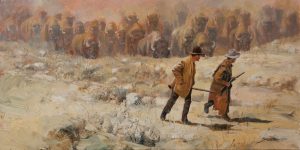 inspired my Legends of the Hunt series,” John responded when asked how he got the idea for the stories and paintings portrayed in the book.
inspired my Legends of the Hunt series,” John responded when asked how he got the idea for the stories and paintings portrayed in the book. - In 2000, John married fellow wildlife artist, Suzie Seerey-Lester.
- In
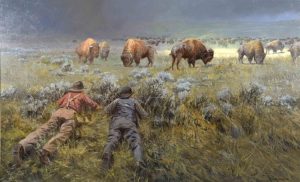 John’s historical series, Legends of the Hunt and Campfire Scenes, the physical act of rendering the painting takes the least amount of time. Said John, “I can spend months researching the subject of the painting, then considerable time is spent on the concept. How will I translate what is in my head into a
John’s historical series, Legends of the Hunt and Campfire Scenes, the physical act of rendering the painting takes the least amount of time. Said John, “I can spend months researching the subject of the painting, then considerable time is spent on the concept. How will I translate what is in my head into a 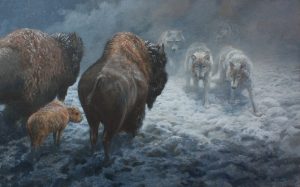 painting?”
painting?” - For Blitz (above), he started by going through his field sketches and photos, deciding how to arrange his composition, then did a preliminary sketch. He then gathered his models and dressed them in historically-accurate period costumes and outfitted them with the necessary guns and artifacts.
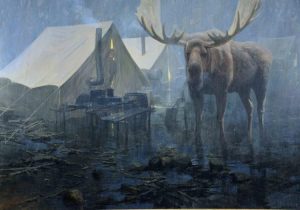 His first sketch was in vine charcoal on canvas. Then using oil, he blocked in the color, which took roughly a day. “I then sat with the painting at this stage for a couple of weeks, while I assessed whether it was going to work or not.” In the case of Blitz, John decided to alter the composition and change the poses of the models before proceeding to the final rendering.
His first sketch was in vine charcoal on canvas. Then using oil, he blocked in the color, which took roughly a day. “I then sat with the painting at this stage for a couple of weeks, while I assessed whether it was going to work or not.” In the case of Blitz, John decided to alter the composition and change the poses of the models before proceeding to the final rendering. 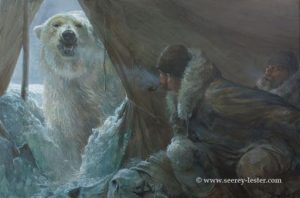 Chuck Snyder, his wife Maureen, John’s wife and fellow artist Suzie and Jack Perkins served as the models in many of Seerey-Lester’s paintings. Perkins, a TV and radio personality, not only resembles Teddy Roosevelt, he is a hunter and equestrian himself. “This provides the added bonus that he knows how to handle and point a gun,” points out Seerey-Lester.
Chuck Snyder, his wife Maureen, John’s wife and fellow artist Suzie and Jack Perkins served as the models in many of Seerey-Lester’s paintings. Perkins, a TV and radio personality, not only resembles Teddy Roosevelt, he is a hunter and equestrian himself. “This provides the added bonus that he knows how to handle and point a gun,” points out Seerey-Lester.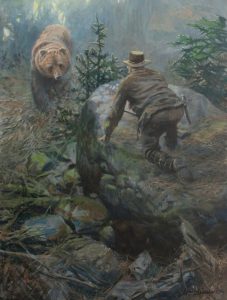 Over the years, he released more than 400 limited edition prints through his publisher, Mill Pond Press.
Over the years, he released more than 400 limited edition prints through his publisher, Mill Pond Press.- John was a master or featured artist for nearly every major wildlife show both in the U.S. and the UK over the past 42 years.
- He and Suzie taught wilderness wildlife workshops for the past 20 years, helping new artist as well as professional artists become better at their craft through master classes in painting fur and wildlife art, birds, water and snow, the elements, grass, rock, trees, skies, painting in the field, painting action and movement, composition and the use of light, creating atmosphere, polar impacts, campfire shadows and animals, anatomy and eyes.
May 25, 2020.














 Tom Hall is both an amateur artist and aspiring novelist who writes art quest thrillers. He is in the final stages of completing his debut novel titled "Art Detective," a story that fictionalizes the discovery of the fabled billion-dollar Impressionist collection of Parisian art dealer Josse Bernheim-Jeune, thought by many to have perished during World War II when the collection's hiding place, Castle de Rastignac in southern France, was destroyed by the Wehrmacht in reprisal for attacks made by members of the Resistance operating in the area. A former tax attorney, Tom holds a bachelor's degree as well as both a juris doctorate and masters of laws in taxation from the University of Florida. Tom lives in Estero, Florida with his fiancee, Connie, and their four cats.
Tom Hall is both an amateur artist and aspiring novelist who writes art quest thrillers. He is in the final stages of completing his debut novel titled "Art Detective," a story that fictionalizes the discovery of the fabled billion-dollar Impressionist collection of Parisian art dealer Josse Bernheim-Jeune, thought by many to have perished during World War II when the collection's hiding place, Castle de Rastignac in southern France, was destroyed by the Wehrmacht in reprisal for attacks made by members of the Resistance operating in the area. A former tax attorney, Tom holds a bachelor's degree as well as both a juris doctorate and masters of laws in taxation from the University of Florida. Tom lives in Estero, Florida with his fiancee, Connie, and their four cats.